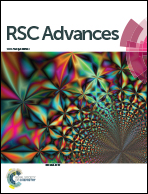Low temperature synthesis of rutile TiO2 single crystal nanorods with exposed (002) facets and their decoration with gold nanoparticles for photocatalytic applications†
Abstract
Uniform rutile TiO2 single crystal nanorods (TNRs) enclosed by a high amount of active (002) facets were synthesized for the first time by treating anatase TiO2 with concentrated HNO3 under hydrothermal conditions. It was found that these TNRs exhibited considerably enhanced photocatalytic activity compared to bulk rutile TiO2 owing to the highly exposed active (002) facets. In addition, gold nanoparticles with diameters of 1–5 nm were successfully deposited on the TNRs (Au/TNRs) using a simple photocatalytic reduction of HAuCl4 by the TNRs in the presence of 2-propanol. The plasmon-induced photocatalytic chemistry of the Au/TNRs under ultraviolet and visible light was investigated. The photocatalytic ability of TNRs was clearly enhanced under ultraviolet light with the decoration of Au nanoparticles. In particular, in our experimental conditions, the Au/TNRs nanocomposite demonstrated much better photocatalytic ability under visible-light than under ultraviolet light. This phenomenon may be attributed to the intense localization of plasmonic near-fields close to the Au/TiO2 interface, which brings about enhanced optical absorption and is good for generating electron–hole pairs for photocatalysis.


 Please wait while we load your content...
Please wait while we load your content...